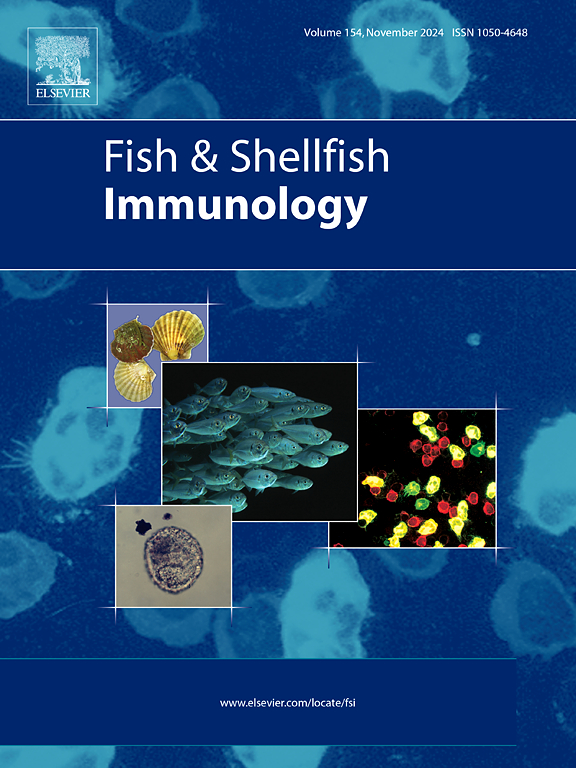Exploring the use of righting time in predicting the immunological condition of echinoderms: A case study with the sea urchin Echinometra lucunter
IF 3.9
2区 农林科学
Q1 FISHERIES
引用次数: 0
Abstract
Studies correlating behavior and health are common for vertebrates but are comparatively limited for invertebrates, particularly within the phylum Echinodermata. Behavioral studies in echinoderms are scarce, chiefly focusing on covering and righting behaviors. Given the lack of consensus on the meaning and potential use of the righting time in echinoderms, measured as the time necessary to return to a natural position after being overturned, the present work aimed to establish links between this behavior and reliable but invasive health indicators. Through an experimental infection with the yeast Saccharomyces cerevisiae, we assessed whether the righting time of the sea urchin Echinometra lucunter mirrored a distruption in cellular and humoral immune markers. Our hypothesis posited that for righting time to serve as a reliable health indicator, infected sea urchins should exhibit extended righting times to match any altered immunological responses, analyzed through cellular and humoral immune parameters. The results demonstrated clear alterations in the latter, including elevated total coelomocyte counts and increased proportions of phagocytes, alongside a decreased proportion of vibratile cells and reduced coelomocyte viability. Furthermore, all analyzed biochemical parameters—specifically total protein and echinochrome concentrations, and alkaline phosphatase activity—increased in yeast-infested animals. However, while the righting time of yeast-infected animals showed a tendency to be elevated compared to that of control animals, it did not significantly differ. Consequently, our findings indicate that righting time does not seem to be a sensitive proxy of the health status of E. lucunter, and its application as a stress marker or predictor of sublethal changes in health condition should be approached with caution in this and other echinoderms.
探索利用翻正时间预测棘皮动物的免疫状态:以海胆Echinometra lucunter为例
将行为与健康联系起来的研究在脊椎动物中很常见,但对无脊椎动物,特别是棘皮动物门的研究相对有限。棘皮动物的行为学研究很少,主要集中在覆盖和扶正行为上。鉴于对棘皮动物翻身时间的含义和潜在用途缺乏共识,目前的工作旨在建立这种行为与可靠但具有侵入性的健康指标之间的联系。翻身时间是指被翻倒后恢复到自然位置所需的时间。通过酵母的实验感染,我们评估了海胆Echinometra lucunter的恢复时间是否反映了细胞和体液免疫标志物的破坏。我们的假设假设,通过细胞和体液免疫参数分析,受感染的海胆应该表现出延长的翻身时间,以匹配任何改变的免疫反应。结果显示后者发生了明显的变化,包括总腔胚细胞计数升高和吞噬细胞比例增加,同时振动细胞比例下降和腔胚细胞活力降低。此外,所有分析的生化参数-特别是总蛋白和刺青色素浓度以及碱性磷酸酶活性-在酵母菌感染的动物中都有所增加。然而,虽然酵母感染动物的翻身时间与对照动物相比有提高的趋势,但差异不显著。因此,我们的研究结果表明,翻正时间似乎并不是一个敏感的健康状况指标,它作为应激标志物或亚致死健康状况变化的预测指标在这种和其他棘皮动物中应该谨慎对待。
本文章由计算机程序翻译,如有差异,请以英文原文为准。
求助全文
约1分钟内获得全文
求助全文
来源期刊

Fish & shellfish immunology
农林科学-海洋与淡水生物学
CiteScore
7.50
自引率
19.10%
发文量
750
审稿时长
68 days
期刊介绍:
Fish and Shellfish Immunology rapidly publishes high-quality, peer-refereed contributions in the expanding fields of fish and shellfish immunology. It presents studies on the basic mechanisms of both the specific and non-specific defense systems, the cells, tissues, and humoral factors involved, their dependence on environmental and intrinsic factors, response to pathogens, response to vaccination, and applied studies on the development of specific vaccines for use in the aquaculture industry.
 求助内容:
求助内容: 应助结果提醒方式:
应助结果提醒方式:


